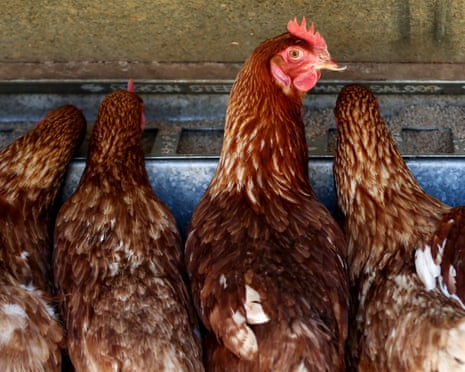Disease and predation are problems in populations that are allowed to roam but animal advocates argue those issues can be mitigated
Sign up for the Rural Network email newsletter
Near Lake Macquarie on the central coast of New South Wales, Belinda Stauner-Dawson is running what appears to be a chicken utopia. Her 60 egg-laying ISA Brown hens – a popular laying breed – have the run of a 1.4-hectare paddock. Each day they have access to fresh, green pasture and they come and go as they please from a chicken caravan – a trailer with a water tank, feed and roosting perches. Keeping a watchful eye over them are two permanent guardian maremma dogs. Stauner-Dawson prides herself on happy chooks and their eggs, with golden yellow yolks, which are sold to farm-gate customers and to an organic butcher.
The utopia is not without challenges. Stauner-Dawson worms her “girls” twice a year and moves the caravan regularly to reduce parasites, and is wary of diseases, such asavian influenza, which may be introduced from wild birds. Predation has also been a major problem in the past.
“I would use electric fencing to control foxes and I used to lose a lot of birds from wedge-tails and sea eagles but since I’ve had the dogs I haven’t lost a single chook to predation,” she says. “If I didn’t have dogs I couldn’t have pasture-raised chickens.”
It’s not a large-scale operation. “It’s not for everyone,” Stauner-Dawson says. “It takes more land with fewer birds and is more expensive. It doesn’t make a lot of money.”
Sixty years ago, most eggs came from free-range and back yard producers. Today, Australia’s19 million hensproducing eggs for our tables are housed in three main systems: caged, barn-raised (often advertised as cage-free) and free range.
The cage system is climate controlled, reduces the occurrence of disease and provides freedom from feather pecking and cannibalism but it confines the animal without perches or nesting boxes. Free-range gives the bird outdoor exposure and allows it to exhibit natural behaviours but can expose it to predation and disease transferred by wild birds. The barn system gives access to perch and nesting boxes while still confining the bird to an indoor environment.
Sign up to receive Guardian Australia’s fortnightly Rural Network email newsletter
Jed Goodfellow is a director of Australian Alliance for Animals and spent eight years involved with the development of theAustralian Animal Welfare Standards and Guidelines for Poultry. He says all three systems have good and bad points, but a significant difference is the cumulative welfare concerns in cage egg production. Mortality rates in free-range systems can be reduced with proper management practices such as the development of proper hygiene protocols and vaccination programs, he says.
“Within the cage system issues such as behavioural deprivation, fatty liver disease and bone breakage on depopulation are inherent in the system itself,” Goodfellow says. “But the welfare issues of cage-free systems such as feather pecking, increased mortality and cannibalism, all of which are serious concerns, can be alleviated as producers become more experienced with the system.”
The Alliance forAnimalsthis month joined a global call for faster action to ban cage eggs, off the back of an investigation in 37 countries, including Australia, which allegedly showed “systemic suffering” in chickens.
Brian Ahmed is the president of the Victorian Farmers Federation egg group and in the 1960s his father started the family egg business with free-range hens, before overseeing the change to caged-egg production in the 1970s.
“Back then you couldn’t control disease and the science showed taking chickens off the ground [into cages] and away from their faeces improved their welfare and reduced parasite issues and the use of antibiotics,” Ahmed says. “We had better control in the sheds and this gave us a more affordable egg.”
Subscribe to Calla Wahlquist's fortnightly update on Australian rural and regional affairs
Ahmed says animal health then was measured by freedom from injury, disease and pain, hunger and thirst and for these reasons caged egg production was considered superior to other farming systems. The psychological wellbeing of the animal, as addressed in contemporary animal welfare science, was not considered in the 1960s.
Goodfellow also points to the EU’s ban of caged-egg production in 2012 in the discussion of chicken welfare. Although Australian eggs are not exported, he believes our continued use of the cage system negatively affects trade relations. “The Europeans are very sensitive about animal welfare generally and the fact Australia continues to permit [cage production] negatively impacts the general perception of Australia’s broader animal welfare standards.”
Greg Mills is a consultant to the egg industry, working primarily with caged egg systems. He pointed to researchcommissioned by the Australian Egg Corporation in 2012, which measured levels of the hormone albumen corticosterone in eggs as a way of measuring the stress of chickens and found “no differences in mean corticosterone concentrations” across production systems – but a significant difference between different farms, even of the same production type.
Mills says it comes down to a question of “mortality or confinement”, arguing that cage systems see lower mortality rates than free range “but as humans we don’t like confinement”. But animal welfare advocates argue that while the risk factors potentially leading to higher mortality rates – like temperature fluctuations and predation – can be managed or reduced in free-range systems, or alleviated entirely in open barn-raised systems, the issues associated with confinement are inherent in cage egg systems.
Some egg producers, such as CanobolasEggsin central NSW and Somerville Eggs near Werribee in Victoria, employ all systems. Lou Napolitano from Somerville Eggs says the diverse business is based purely on market demands but his preference from an animal welfare standard remains cage or simple barns.
“The worst thing you can do to chooks is let them out,” Napolitano says. “When you let them out there is no biosecurity because they mix with wildlife; it looks nice when they are free-ranging but it is very deceiving. Disease can still get in cages, but biosecurity can be better controlled. All I have to do is open the door of our sheds and listen. The hens are all chattering and cackling and telling us everything is fine.”
Sign up for the Rural Network email newsletter
















